Have a question that’s not answered below? Contact us.
Questions about Abogo
Where does the name “Abogo” come from?
What is “Location Efficiency”?
What is sustainability?
Why do you say my housing and transportation costs should be less than 45% of my income?
Questions about transportation costs
How does Abogo calculate transportation costs?
How can I lower my transportation costs?
Why are the transportation costs for my address different from what I actually spend?
Why doesn’t it ask me where I work?
What does the “region” mean in “regional averages”?
How much is a metric ton of CO2?
Questions about the Gas Slider
What does the Gas Slider do?
Where do you get the gas price data?
Why does your model use 2015 gas prices?
Does your model assume people drive less as gas prices rise?
About Abogo
Where does the name “Abogo” come from?
“Abogo” combines the words abode and go. Where you live and how much you spend getting around are interrelated. Abogo helps you consider both together.
What is “Location Efficiency”?
Just as buildings can be energy efficient, city neighborhoods can be location efficient. Compact neighborhoods with walkable streets, access to jobs and transit, and a wide variety of stores and services have high location efficiency. They require less time, money and greenhouse gas emissions for residents to meet their everyday travel needs.
The savings of location efficiency add up for households and communities. Transportation costs can range from 8% of household income in location-efficient neighborhoods to over 26% in inefficient locations. Greenhouse gas emissions also fluctuate, depending on household reliance on costly, carbon-intensive automobile travel.
Learn more about Location Efficiency here.
What is sustainability?
True sustainability requires balancing environmental, economic, and social considerations. With Abogo, you can evaluate the impact that your choice of neighborhood will have on the economic and environmental sustainability of your lifestyle. Happily, what’s good for your wallet is often also good for the earth: a shorter commute with less driving is more eco-friendly, and it will likely save you money and improve your quality of life.
Why do you say my housing and transportation costs should be less than 45% of my income?
Traditionally, a home is deemed affordable if its costs consume no more than 30% of a household’s income. This measure, however, ignores transportation costs – typically a household’s second-largest expenditure – which are largely a function of the area in which a household chooses to locate. Based on research in metropolitan areas ranging from large cities with extensive transit to small micropolitan areas with extremely limited transit options, CNT has found that 15% of the Area Median Income (AMI) is an attainable goal for transportation affordability. By combining this 15% level with the 30% housing affordability standard, CNT recommends a new view of affordability, one in which combined housing and transportation costs consume no more than 45% of household income.
Transportation costs
How does Abogo calculate transportation costs?
What you see are average transportation costs for a typical household in your neighborhood, and are based on neighborhood and regional characteristics. See How it Works for a brief explanation, or if you’re really interested in the nitty-gritty details, you can read the Methods for the Housing and Transportation (H+T®) Affordability Index.
How can I lower my transportation costs?
Walk. Bike. Take public transit. See Lower Your Costs for more ideas on how to spend less on transportation.
Why are the transportation costs for my address different from what I actually spend?
Abogo estimates average transportation costs for a typical regional household using a transportation cost model, so they’re an estimate for the region’s average household living in your specific location.
Why doesn’t it ask me where I work?
Abogo gives an estimate for all trips made by a household, not just the commute. It’s important to remember that the commute is only 1 in 7 trips a household makes, and only takes up 18% of total miles driven.
What does the “region” mean in “regional averages”?
The regions used in Abogo correspond to Census definitions – specifically, Core Based Statistical Areas (CBSAs) defined by the Office of Management and Budget (OMB) for use by federal statistical agencies. The term Core Based Statistical Area (CBSA) refers to both metropolitan and micropolitan areas.
How much is a metric ton of CO2?
A metric ton, which is equal to 1000 kilograms, isn’t a quantity most of us deal with on a regular basis. For perspective, think of it this way: to get a metric ton of CO2, you’d have to burn 2.33 barrels of oil. And then it would take 3077 trees a whole month to reabsorb that one metric ton.
Gas Slider
What does the Gas Slider do?
The Abogo Gas Slider allows you to change the price of gas used to estimate the total cost of transportation for a typical regional family living at a chosen address. You can choose 50 cent increments from $3 to $7. It looks at the National Average Gas price, and you can click ‘reset’ to return it to that exact price.
Where do you get the gas price data?
We use data from the US Energy Information Agency.
Why does your model use 2015 gas prices?
On the Abogo site and map, we show a transportation cost based on travel behavior as observed in 2015. We use this year because most of the data in the model comes from the 2011-15 American Community Survey 5-year estimates (ACS).
Does your model assume people drive less as gas prices rise?
No, our model keeps vehicle miles traveled (VMT) constant. Because our model was constructed to represent a snapshot in time (2011-15), we cannot make sound assumptions about how travel behavior has changed.


